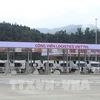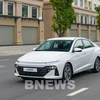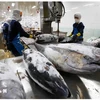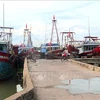The Mekong Delta’s Tra Vinh province has scaled up efforts to improve its investment climate. Scores of key national-level projects are underway, a clear sign the province is on the up.
Tra Vinh provincial People’s Committee Deputy Chairman Dong Van Lam underscores with Vietnam Investment Review the locality’s efforts to enhance its appeal among investors.
* Can you brief us on the province’s main advantages and areas of interest that may be attractive to investors?
Tra Vinh is in the southeast of the Mekong Delta, faces the East Sea and has over 65 kilometres of coastline. It sits between the Co Chien and Hau rivers and is home to two of the delta’s major estuaries which facilitate water transport. The province is also home to Highways 53, 54 and 60, linking it with other provinces such as Ben Tre, Vinh Long and Soc Trang, as well as Can Tho city. It is 130 km from Ho Chi Minh City and 70km from Can Tho.
In terms of human resources, more than 70 percent of the population is at the working age group and 34 percent have taken occupational training courses. Tra Vinh has a mild climate and is less susceptible to floods and storms than surrounding localities. The province has an abundant potential for agriculture, great for processing industries.
Numerous national-level projects are underway which are spurring the local socio-economic development. The projects involve dredging the Hau River to make it accessible to bigger ships, construction of the coastal power centre, the Dinh An economic zone (EZ) and Cau Quan and Co Chien industrial parks (IP). The province is also planning industrial clusters in several districts and in Tra Vinh city.
* What are the projects that may be of most interest to potential investors?
Through the Vietnamese Government’s support and great efforts, there are a number of key projects already going in the province and these are expected to appeal to new investors.
The most notable projects are the previously mentioned Hau river dredging which will allow the accommodation of 20,000DWT ships, as well as the Dinh An estuary’s potential to grow into an international transit port, and lastly Co Chien Bridge which will connect it with Ben Tre province.
* What has been done to improve the local investment climate?
The provincial competitiveness index (PCI) has become a cost-efficient tool for our management to plan and execute activities that push forward administrative reforms, making the province more attractive to investors. In 2012, Tra Vinh ranked eighth among the 63 cities and provinces nationwide.
Tra Vinh authorities view investors as distinguished guests and are happy to offer them the best possible incentives for those that seek a long-term commitment with us.
* Can you please elaborate on policies and measures to attract investment?
Authorities have paid special attention to introducing and updating incentive policies related to investment locations, infrastructure, land rentals, technology transfers, labour training, and science and technology activities that best serve investors.
We have also put a lot of efforts into transforming the province into a one-stop-shop. As for technical infrastructure, great energy has been exerted into upgrading the infrastructure system including transport, power, water, and telecoms to make it a convenient place to live, work and trade.
As a result, the province has attracted 30 foreign investment projects thus far valued at 121 million USD and 109 domestic projects at 95 trillion VND (4.5 billion USD) across a wide spectrum of areas including garments, footwear, chemicals, agriculture and seafood processing, tourism, cattle feed processing, healthcare, seaports, electronics, and telecommunications.
* What projects are currently regarded as priorities?
Tra Vinh prioritises investments into a few major areas.
The first is technical infrastructure including works related to EZs and IPs. The second is agricultural production, including developing material areas that apply new technologies, which includes high-quality rice and fruit growing areas and animal husbandry. The third are industries such as food processing, shipbuilding and repairs, support industry for electronics and IT, assembling and manufacturing, and engineering. Finally, tourism and entertainment.
In terms of realising its socio-economic strategy, Tra Vinh is very aware of the importance of co-operation with other locations, both local and international, in spurring development.
* What are some of the intrinsic benefits and advantages that may lure investors?
I can think of several.
Firstly, in light of the national investment strategy and sea development strategy, Tra Vinh will complete projects vital to our tackling problems with our geographical position to push up production and trade and achieve sustainable development.
Secondly, Tra Vinh has a sizable workforce and solid training programmes and facilities. It is home to abundant material sources such as agriculture and seafood to attract processing industries.
Thirdly, we have been working hard at improving transport through infrastructure projects. Three highways run through our province that connect to other delta regions.
Fourth, IPs, EZs, and industrial clusters are in the pipeline. Low-cost land is available in many areas. and
Fifth, investment is the focal point of management and authorities. Investors will be supported and encouraged and we aim to provide them with the best possible environment for their business and lifestyle.-VNA
Tra Vinh provincial People’s Committee Deputy Chairman Dong Van Lam underscores with Vietnam Investment Review the locality’s efforts to enhance its appeal among investors.
* Can you brief us on the province’s main advantages and areas of interest that may be attractive to investors?
Tra Vinh is in the southeast of the Mekong Delta, faces the East Sea and has over 65 kilometres of coastline. It sits between the Co Chien and Hau rivers and is home to two of the delta’s major estuaries which facilitate water transport. The province is also home to Highways 53, 54 and 60, linking it with other provinces such as Ben Tre, Vinh Long and Soc Trang, as well as Can Tho city. It is 130 km from Ho Chi Minh City and 70km from Can Tho.
In terms of human resources, more than 70 percent of the population is at the working age group and 34 percent have taken occupational training courses. Tra Vinh has a mild climate and is less susceptible to floods and storms than surrounding localities. The province has an abundant potential for agriculture, great for processing industries.
Numerous national-level projects are underway which are spurring the local socio-economic development. The projects involve dredging the Hau River to make it accessible to bigger ships, construction of the coastal power centre, the Dinh An economic zone (EZ) and Cau Quan and Co Chien industrial parks (IP). The province is also planning industrial clusters in several districts and in Tra Vinh city.
* What are the projects that may be of most interest to potential investors?
Through the Vietnamese Government’s support and great efforts, there are a number of key projects already going in the province and these are expected to appeal to new investors.
The most notable projects are the previously mentioned Hau river dredging which will allow the accommodation of 20,000DWT ships, as well as the Dinh An estuary’s potential to grow into an international transit port, and lastly Co Chien Bridge which will connect it with Ben Tre province.
* What has been done to improve the local investment climate?
The provincial competitiveness index (PCI) has become a cost-efficient tool for our management to plan and execute activities that push forward administrative reforms, making the province more attractive to investors. In 2012, Tra Vinh ranked eighth among the 63 cities and provinces nationwide.
Tra Vinh authorities view investors as distinguished guests and are happy to offer them the best possible incentives for those that seek a long-term commitment with us.
* Can you please elaborate on policies and measures to attract investment?
Authorities have paid special attention to introducing and updating incentive policies related to investment locations, infrastructure, land rentals, technology transfers, labour training, and science and technology activities that best serve investors.
We have also put a lot of efforts into transforming the province into a one-stop-shop. As for technical infrastructure, great energy has been exerted into upgrading the infrastructure system including transport, power, water, and telecoms to make it a convenient place to live, work and trade.
As a result, the province has attracted 30 foreign investment projects thus far valued at 121 million USD and 109 domestic projects at 95 trillion VND (4.5 billion USD) across a wide spectrum of areas including garments, footwear, chemicals, agriculture and seafood processing, tourism, cattle feed processing, healthcare, seaports, electronics, and telecommunications.
* What projects are currently regarded as priorities?
Tra Vinh prioritises investments into a few major areas.
The first is technical infrastructure including works related to EZs and IPs. The second is agricultural production, including developing material areas that apply new technologies, which includes high-quality rice and fruit growing areas and animal husbandry. The third are industries such as food processing, shipbuilding and repairs, support industry for electronics and IT, assembling and manufacturing, and engineering. Finally, tourism and entertainment.
In terms of realising its socio-economic strategy, Tra Vinh is very aware of the importance of co-operation with other locations, both local and international, in spurring development.
* What are some of the intrinsic benefits and advantages that may lure investors?
I can think of several.
Firstly, in light of the national investment strategy and sea development strategy, Tra Vinh will complete projects vital to our tackling problems with our geographical position to push up production and trade and achieve sustainable development.
Secondly, Tra Vinh has a sizable workforce and solid training programmes and facilities. It is home to abundant material sources such as agriculture and seafood to attract processing industries.
Thirdly, we have been working hard at improving transport through infrastructure projects. Three highways run through our province that connect to other delta regions.
Fourth, IPs, EZs, and industrial clusters are in the pipeline. Low-cost land is available in many areas. and
Fifth, investment is the focal point of management and authorities. Investors will be supported and encouraged and we aim to provide them with the best possible environment for their business and lifestyle.-VNA



















